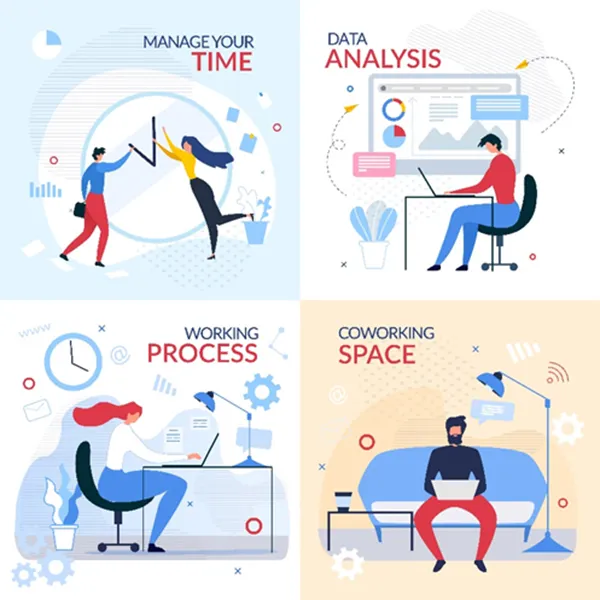
Menu

Menu

In any online search for current trends in HR, improving employee experience consistently emerges as a critical strategy for increasing engagement and enhancing the employee value proposition (EVP). In fact, a report based on a survey of 800 global HR leaders, recently released by Gartner, lists “Employee Experience” as one of the top five priorities for 2021 (Source: Gartner 2021 Future of HR Survey).
Moreover, the pandemic has significantly prompted businesses to realign their human resource strategies. Consequently, organizations are now looking for innovative ways to create a more personalized, flexible, and attractive working environment for employees. This shift not only improves employee satisfaction but also positions the organization to attract the best talent in the future, enhancing its competitive edge in the market.
To begin with, consider adapting your recruitment model to reduce dependence on traditional interview processes. While some candidates excel at interviews, others find them to be an insurmountable hurdle. This discrepancy underscores the need for a more inclusive recruitment approach. Therefore, recruitment activities should embrace creativity by utilizing assessments that consider personality, cultural fit, and potential.
Additionally, it may be beneficial to explore recruitment activities not solely focused on specific roles. Instead, aim to identify where individuals could fit and add value across the organization. This approach fosters a more holistic understanding of candidates and enhances the likelihood of long-term employee satisfaction.

Furthermore, typical onboarding processes often involve new employees arriving at the office to be introduced to their team, followed by a visit to HR to read through numerous documents. Rather than adhering to this outdated model, consider personalizing the onboarding experience to suit individual new joiners. For instance, allocating a “buddy” from the team can significantly help guide new employees through the essentials, ensuring they feel supported during their initial months.
In addition, strive to ensure that the training and information new hires receive is relevant, both in terms of their role and timing. For example, it’s frustrating for new employees to be inundated with details about the annual performance review process when they won’t experience this for several months. However, it is crucial that they understand how their performance will be monitored and what role they are expected to take in the process. Therefore, tailoring this experience not only aids retention but also sets a positive tone for their journey within the company.
Moreover, giving employees the opportunity to influence their job roles can yield significant benefits. When employees can help craft their roles and define their objectives, they are more likely to take ownership of their work. Not only does this lead to greater buy-in, but it also enhances their motivation and performance.
Furthermore, involving employees in this process fosters a sense of agency, leading to increased job satisfaction and decreased turnover. When employees feel their contributions are valued and that they have a say in their career paths, they are more likely to remain engaged and committed to the organization.
In light of the pandemic, traditional salary-focused compensation models have faced numerous challenges, including salary freezes and reductions. As an alternative, consider offering employees the option to select from a range of benefits tailored to their individual circumstances, needs, and values. This flexibility not only demonstrates that the organization cares about its employees but also allows for greater customization based on personal preferences.

Additionally, it’s important to recognize that employee needs and preferences may evolve over time. Therefore, revisiting and updating benefits periodically is a good practice. For instance, employees might appreciate options such as subsidized childcare facilities, wellness programs, or additional vacation days. By offering a selection of benefits, organizations can create a competitive edge that attracts and retains top talent.
The physical work environment has long been influenced by trends in office design. However, the pandemic has introduced new considerations, making it an opportune time to reevaluate workplace settings. Consequently, consider the value that individuals place on various working arrangements, such as open-plan vs. cubicle settings, or home vs. office locations.
Moreover, it is essential to adopt a flexible mindset that accommodates individual employee preferences. For instance, some employees may thrive in a collaborative open environment, while others may require a quieter, more private space to concentrate effectively. Thus, providing options for individual employees and teams is now more important than ever. This flexibility can significantly impact employee satisfaction and productivity.
Given the pervasive influence and accessibility of technology, there are now numerous ways to communicate with employees. Therefore, consider introducing a wider range of communication options, particularly when employees are working remotely or on flexible hours.

In addition to standard email communications, explore corporate channels such as Slack, Microsoft Teams, or Yammer, which facilitate real-time interactions and collaboration. Moreover, personal channels like WhatsApp or Instagram can enhance connectivity among team members. Utilizing visual communication formats, such as video messages or infographics, can also be more engaging than traditional text-based communication. Finally, incorporating QR codes or NFC smart posters to link employees to more detailed information can further enhance engagement and access to resources.
Traditionally, performance reviews aim to identify strengths and gaps in employee performance. However, why not also consider using these reviews to map individuals to the best team or manager for optimal performance? For instance, an employee who values autonomy and creativity may not thrive under a directive management style.
Conversely, employees who require more structure and guidance may excel under a directive manager. By thoughtfully aligning employees with the right managers and teams, organizations can significantly enhance overall performance and job satisfaction. This strategy fosters an environment where employees feel empowered and are more likely to contribute positively to the organization’s goals.
Additionally, broadening your view of learning and development to include informal learning opportunities or learning “in the flow of work” is beneficial. This approach leads to a more personalized learning experience and engages employees with their managers and supervisors in development and performance improvement.
Moreover, allowing employees to choose how they learn new skills or acquire knowledge can significantly increase their engagement. By supporting a culture of self-development, organizations empower employees to take charge of their professional growth. Consequently, this shift transforms the role of learning and development teams into guides, coaches, and curators of content, fostering a supportive environment where employees can thrive.
Finally, a core factor in improving employee experience is ensuring that HR systems and processes leverage the latest technology. This investment not only enhances operational efficiency but also provides valuable data to monitor and adapt working practices.
Additionally, it’s crucial that these systems are simple and accessible for employees, providing them with visibility and opportunities to interact directly with HR teams. By streamlining HR processes and ensuring ease of access, organizations can enhance overall productivity and employee satisfaction.

By focusing on personalized employee experiences, organizations can significantly boost engagement levels. As a result, this leads to higher productivity, increased creativity, and improved morale, creating a positive feedback loop that benefits the entire organization. Furthermore, engaged employees are more likely to advocate for their employer, thereby enhancing the company’s reputation. Consequently, this increased advocacy can attract top talent, making it easier for organizations to build a strong workforce that aligns with their values and goals.
When employees feel valued and supported through personalized onboarding and tailored job roles, they are more likely to remain with the organization. In fact, studies have shown that organizations with high employee satisfaction experience lower turnover rates. This reduction in turnover not only decreases associated costs, such as recruitment and training expenses, but also fosters a more stable work environment. Additionally, retaining experienced employees contributes to knowledge retention, which is crucial for maintaining operational continuity and ensuring that the organization can quickly adapt to changes in the market.
Adapting recruitment processes to focus on cultural fit and potential can lead to better hires. Consequently, by fostering a more inclusive and creative recruitment model, organizations can attract a diverse talent pool. This diversity not only enriches the workplace culture but also drives innovation and enhances problem-solving capabilities within teams. Moreover, organizations that prioritize diversity and inclusion are often seen as more attractive to prospective employees, further improving recruitment outcomes and enabling the company to stay ahead in a competitive job market.
Personalizing the employee experience significantly contributes to a supportive workplace culture. When employees feel connected and understood, it fosters collaboration and community within the organization. Consequently, this strong workplace culture enhances employee satisfaction and loyalty, reducing the likelihood of workplace conflicts. Additionally, a positive culture can lead to improved teamwork and communication, which are essential for achieving organizational objectives. Ultimately, a robust workplace culture becomes a magnet for talent, making it easier for organizations to attract and retain high-performing employees.
Providing options for compensation, benefits, and working environments allows organizations to adapt to changing employee needs. This flexibility not only improves employee satisfaction but also leads to a more resilient workforce capable of thriving amid challenges. Moreover, organizations that embrace adaptability are better equipped to navigate uncertainties and capitalize on emerging opportunities. In turn, this adaptability enhances overall organizational performance and competitiveness, enabling companies to respond effectively to market shifts and evolving employee expectations.
Supporting informal learning and development increases employee satisfaction and engagement. When employees are encouraged to take initiative in their own development, they are more likely to seek out learning opportunities that align with their interests and career goals. Furthermore, this proactive approach fosters a culture of continuous improvement, where employees feel empowered to share their knowledge and skills with colleagues. Consequently, organizations benefit from a workforce that is not only more skilled but also more capable of responding to evolving market demands and challenges, thereby driving innovation and growth.
Implementing advanced HR technology streamlines processes, making it easier for employees to access information and resources. By enhancing efficiency, organizations can free up HR teams to focus on strategic initiatives rather than administrative tasks. Moreover, simplified processes improve the employee experience by reducing frustration and increasing engagement. As a result, employees are more likely to interact positively with HR teams, fostering a culture of open communication and collaboration. Ultimately, streamlined HR processes contribute to a more agile organization that can quickly adapt to changes and seize new opportunities.
By prioritizing a positive employee experience, organizations can directly enhance productivity levels. When employees feel supported and engaged, they are more motivated to perform at their best. Consequently, this leads to increased output and efficiency, as employees are less likely to feel burned out or disengaged. Furthermore, productivity gains can have a ripple effect throughout the organization, leading to improved team performance and ultimately contributing to the company’s bottom line.
A positive employee experience fosters an environment where innovation can thrive. When employees feel comfortable and valued, they are more likely to share their ideas and take risks, ultimately driving creativity within the organization. Moreover, organizations that encourage open communication and collaboration can harness diverse perspectives, leading to innovative solutions and products. Consequently, this culture of creativity not only benefits the organization internally but also helps to meet and exceed customer expectations.
When employees have a positive experience at work, they are more likely to provide excellent service to customers. This connection between employee experience and customer satisfaction is crucial, as happy employees tend to be more engaged and committed to their roles. As a result, organizations can expect to see improvements in customer loyalty and retention, leading to a stronger overall brand reputation. Additionally, satisfied customers often share their experiences with others, further enhancing the company’s visibility and attractiveness in the marketplace.
Organizations that focus on employee experience are often more agile and responsive to change. By fostering a culture of adaptability, employees feel empowered to embrace new challenges and initiatives. This increased agility allows organizations to pivot quickly in response to market shifts or unforeseen circumstances. Furthermore, an agile workforce can lead to quicker decision-making and improved problem-solving capabilities, enabling the organization to maintain a competitive edge in an ever-evolving business landscape.
Companies that prioritize employee experience naturally enhance their employer brand. When employees are happy and engaged, they become advocates for the organization, sharing their positive experiences with potential candidates and customers alike. This positive word-of-mouth can attract top talent and improve recruitment outcomes, making it easier for the organization to fill open positions with qualified candidates. Moreover, a strong employer brand can lead to increased loyalty from customers who prefer to support companies known for treating their employees well.
Improving employee experience can significantly reduce absenteeism and health-related issues within the workplace. When employees feel valued and supported, they are less likely to experience stress and burnout, leading to better overall well-being. Consequently, healthier employees are more likely to show up for work and perform at their best. Additionally, organizations that prioritize employee well-being may benefit from lower healthcare costs, further enhancing their financial performance.
A focus on improving employee experience often involves creating a more inclusive workplace where diverse voices are heard and valued. By fostering an environment of inclusion, organizations can benefit from a wider range of perspectives and ideas, ultimately driving better decision-making and innovation. Moreover, a diverse and inclusive workplace enhances employee morale and satisfaction, contributing to a positive culture that attracts and retains top talent from various backgrounds.
Organizations that prioritize employee experience often invest in leadership development programs. By providing opportunities for employees to grow and take on leadership roles, organizations can cultivate a pipeline of future leaders. This investment not only benefits the individuals involved but also strengthens the organization as a whole. Moreover, strong leaders can drive engagement and productivity, creating a virtuous cycle that enhances overall organizational performance.
In summary, improving employee experience is crucial at every stage of the employee lifecycle. It involves creating an environment where employees can influence their experiences and where there is flexibility regarding how they work and how they are recognized and rewarded.
Ultimately, thinking creatively about how to enhance the employee experience is a core success factor for HR teams. This approach not only contributes to a positive organizational culture but also impacts the bottom line results, driving overall success and growth.
To find out more about how our unique HR solution can help you improve your employee experience and simplify your HR operations, click here.
Alignment
Article
Audit
Automation
Benefits
Candidate
Communication
Compliance
Digitalisation
Digital Technology
Diversity
Emirates Id Application
Employee Experience
ESS
Feedback
Health and Safety
HRMS
HR Strategy
HR System UAE
Human Resource Management
Human Resource Management Systems
Job Roles
Learning and Development
Onboarding
Outsource
Payroll
Payroll Management System
Payroll Processing
Performance
Performance Management
Personalisation
Recruit
Recruiting
Recruitment
Remote Working
Rewards
Security
Service Providers
Skills
Smart
Survey
Virtual
Visa Cancellation
Work Environment
Workforce
© 2025 Pruvity HR Solutions Pvt Ltd, Madurai, India